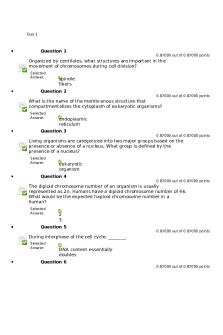A&P Pre-Lab Quiz- Exercise 7 & 8 Answer key PDF

| Title | A&P Pre-Lab Quiz- Exercise 7 & 8 Answer key |
|---|---|
| Author | Vanessa Tavarez |
| Course | Anatomy and Physiology I Laboratory |
| Institution | The University of Texas at Tyler |
| Pages | 4 |
| File Size | 94.7 KB |
| File Type | |
| Total Downloads | 32 |
| Total Views | 133 |
Summary
Quiz used to study for upcoming exams....
Description
A&P Pre-Lab Quiz- Exercise 7 & 8 1. Skin has two distict regions- the superficial epidermis composed of epithelium and an underlying connective tissue dermis, which are firmly attached to each other. -
True
-
False
2. Which of the following is FALSE? -
The hypodermis is not considered part of the integumentary
-
Keratinocytes are the most abundant epidermal cells
-
Melanin serves to shield DNA from the dangling effects of UV radiation
-
Langerhan’s cells are a type of phagocytic cell which play a role in immunity
-
None of the above are false
3. The stratum basale (basal layer) is also known as the stratum granulosum. -
True
-
False
4. Name two of the accessory organs of the skin. -
Nails & Hair
5. What is the relationship between the presence of hair, and the thickness of the skin? -
As the skin gets thicker, the amount of hair is decreased.
6. Which of the following is NOT a function of the skin? -
Regulation of heat loss
-
Prevents water loss
-
Sensory reception
-
Prevents mechanical and chemical damage
-
All of the above are functions of skin
7. A long bone consists of a shaft composed of ________ and an end composed of ________. -
Trabeculae, hard solid bone
-
Compact bone, compact bone
-
Compact bone, spongy bone covered by compact bone
-
Spongy bone, compact bone
8. In adults, ________ marrow fills the central canal of long bones, and ________ marrow is found in the epiphyses of the long bones. -
Red, red
-
Yellow, yellow
-
Yellow, red
-
Red, yellow
9. This membrane lines the shaft of long bones, and covers the trabeculae of spongy bone. -
Epiphysis
-
Endosteum
-
Periosteum
-
Perforating fibers
10. ____________ are the telescoping tubes of matrix (concentric lamellae) with their central canals that form a large part of compact bone. -
Lacunae
-
Trabeculae
-
Osteons
-
Osteocytes
11. Bones are somewhat flexible due to _______. -
Calcium salts in the ground substance
-
Soft, pliable ground substance of the matrix
-
Elastic fibers in the matrix
-
Collagen fibers in the matrix
12. Mature bone cell are located in ___________, which are arranged in concentric circled called concentric lamellae. -
Lacunae
13. Which of the following is FALSE? -
Each cartilage of the skeleton is surrounded by a covering of dense connective tissue
-
The perichondrium plays a role in cartilage growth and repair
-
The three types of cartilage include hyaline, elastic, and fibrous
-
Cartilage contains both nerves and blood vessels
-
All of the above are true
14. Endochondral ossification uses hyaline cartilage as the pattern for bone formation, and is the process through which most bones of the skeleton develop in the embryo. -
True
-
False
15. Which of the following is NOT a function of the skeleton? -
Lipid storage
-
Mineral storage
-
Site for blood cell formation
-
Support and protection
-
All of the above are functions of skeleton
16. Compact bone look smooth and homogenous, while spongy bone is composed of small trabeculae and lots of open space. -
True
-
False
17. Bony tissue, especially compact bone, is organized around its blood supply. -
True
-
False...
Similar Free PDFs

Answer Key Quiz #7 - quiz
- 2 Pages

Answer Key Quiz #11 - quiz
- 4 Pages

Quiz5 - Quiz Answer Key
- 7 Pages

Quiz 1 Answer Key
- 5 Pages

Chemlab QUIZ Answer KEY
- 2 Pages

Quiz 1 Answer Key
- 3 Pages

Photosynthesis Quiz answer key
- 2 Pages

NERO142 Answer Key 8
- 4 Pages

Chapter 8 Quiz KEY
- 1 Pages

Quiz 4 Answer Key Revised
- 2 Pages
Popular Institutions
- Tinajero National High School - Annex
- Politeknik Caltex Riau
- Yokohama City University
- SGT University
- University of Al-Qadisiyah
- Divine Word College of Vigan
- Techniek College Rotterdam
- Universidade de Santiago
- Universiti Teknologi MARA Cawangan Johor Kampus Pasir Gudang
- Poltekkes Kemenkes Yogyakarta
- Baguio City National High School
- Colegio san marcos
- preparatoria uno
- Centro de Bachillerato Tecnológico Industrial y de Servicios No. 107
- Dalian Maritime University
- Quang Trung Secondary School
- Colegio Tecnológico en Informática
- Corporación Regional de Educación Superior
- Grupo CEDVA
- Dar Al Uloom University
- Centro de Estudios Preuniversitarios de la Universidad Nacional de Ingeniería
- 上智大学
- Aakash International School, Nuna Majara
- San Felipe Neri Catholic School
- Kang Chiao International School - New Taipei City
- Misamis Occidental National High School
- Institución Educativa Escuela Normal Juan Ladrilleros
- Kolehiyo ng Pantukan
- Batanes State College
- Instituto Continental
- Sekolah Menengah Kejuruan Kesehatan Kaltara (Tarakan)
- Colegio de La Inmaculada Concepcion - Cebu





